Lions and Tigers and Bears, Oh My!
And a Groundhog or Two
Cathy Koos
Winter holidays will wrap up on February 2 with Candlemas and Ground Hog Day, when we will see a parade of solemn cloaked gentlemen in top hats, a groundhog tucked under their arm pronouncing winter’s end.
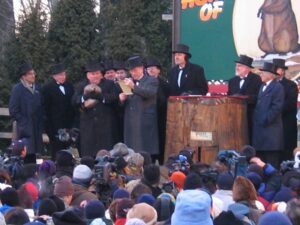
With short winter days and long nights, cultures around the world do their best to frighten children (and adults) into good behavior. From the Italian Varvuole to the German Krampus to the Mummers of England and Philadelphia, to the Bulgarian Kukeri, fanciful and frightful costumes contribute to the scene. Even as jolly Santa and kindly St. Nicolaus bring gifts at Christmas, these frightful creatures often visit during the dead of winter around Solstice, Yule, Epiphany, and Roc Day.
As we see on the silver screen and contemporary theater stages around the world, costumes allow mere mortals to become their Wizard characters. Simple or intricate, donning a costume transforms us, be it the Scarecrow, the Tinman, Santa or a witch. Costume makers over the ages have turned a deft hand and a creative imagination to allow these transformations.
Witches of the Sea. While Befana, the old lady astride a broom brings gifts to most children in Italy on the Feast of the Epiphany on January 6, kiddies in the small northeastern port village of Grado anxiously await the arrival of the Varvuole, or the Witches of the Sea. As darkness comes, locals gather at the town’s harbor. Frequent winter fog helps set the spooky stage. A solemn voice announces, “They … are …. coming.”
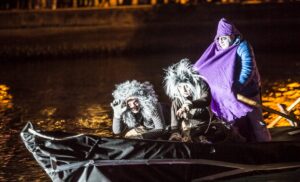
Atlas Obscura
Drums begin, beat by hooded men. Excitement mixed with fear ripples through the crowd. Gliding through the fog come rowboats paddled by cloaked men. Lanterns on hooks in the bow of the boat cast their light illuminating strange creatures on board. The masked Sea Witches are garbed in torn, gauzy black robes. Atlas Obscura says they look like Edward Scissorhands married a zombie and they gave birth to these creatures. Like zombies, the hissing witches disembark and begin to chase the children through the narrow winding streets of Grado.
Then a band of local women appear, armed with garlic and wood crosses and wearing the regional folk dress. A battle ensues and the sea witches are driven back to the harbor and whisked away on boats, back to the dark until next year.
This tradition probably stems from a blending of winter witch myths and real pirates that attacked the region in the 14th century. Today, the women who portray the sea witches spend many hours designing their most frightening costumes, all the better to scare the crowd. They use white grease paint on their faces and draw dark circles around their eyes. Black flowing raggedy robes and wild head dresses complete the look.
Krampus. Further north in Germany, Krampus wreaks havoc by following Santa Claus. On December 6, while Santa gives the good children little gifts, Krampus doles out punishment for the naughty kids with his birch rod. Looking like he should be a pal of the Sanderson Sisters (think “Hocus Pocus,” the movie) the Krampus costume is your worst nightmare, with a horned head piece, a pitchfork, and a devilishly long tongue and tail. The Krampus tradition likely dates to the 6th or 7th century as a result of frightening winter folk tales.
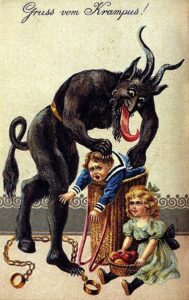
Krampus, Wikipedia
Mummers. Which brings me to the isolated geographical tradition of the Mummers. As a child growing up in the rural area surrounding Philadelphia, I thought every community had Mummers. On New Year’s Day, we didn’t watch the Rose Parade or Macy’s Parade. Oh no. We watched the Mummers strutting their stuff through South Philly. This parade dates to the earliest colonial days of the mid-17th century. The mid-Atlantic region saw this mash-up of Swedish, Welsh, and German cultures with a heavy draw on the Mummers tradition of Ireland and England.
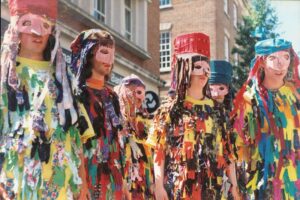
Mummers of Exeter, UK Wikipedia
Beginning with visiting neighbors on the Second Day of Christmas and men loudly parading through neighborhoods demanding a sip of whiskey, this tradition eventually morphed into a more sedate parade from South Philly to Center City. Now each neighborhood has their own string band with elaborate feathered costumes that “struts their stuff,” in a weaving, bobbing, comical walking dance. Once an all-male event, women’s teams were finally admitted to the parade in the 1970s. More entertaining clown than scary being, New Year’s in Philly wouldn’t be the same without the Mummers.
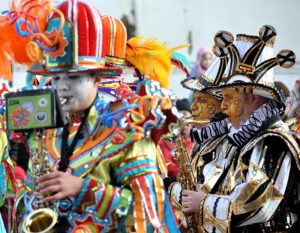
Mummer Band, Philadelphia, Wikipedia
Belsnickel is another winter character based on an old German myth. Costumed like a wild woodsman and wearing a deer antler headdress, this fellow is also a focused on the naughty list. Unlike Krampus, Belsnickel travels alone and during his visit he interrogates the kids about their behavior. Nice kids get a cake or candy, but the naughty ones, a swat.
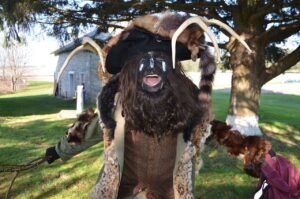
Belsnickel, VisitPA.com
Kukeri of Bulgaria. You definitely want to have these frightful-looking, bell-ringing fellows handy, because they scare away evil spirits. Dating back to ancient, pagan, Thracian days, fur garbed Kukeri appear in late winter to herald in spring and assure fecundity of farm animals, as well as to cast protection on the entire village.
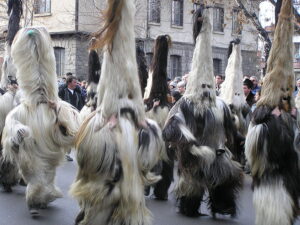
Kukeri, By Original uploader was Ivaneskoto at bg.wikipedia – Transferred from bg.wikipedia, Public Domain
Many a long haired cashmere goat gave up its fleece for each costume, locks rippling as each Kukeri dances in step.
By the time winter releases its icy grip in another month and green hillsides promise spring’s arrival, the naughty (or nice) kids of early winter will ready themselves for the arrival of another costumed fellow, the convivial Easter Bunny.
Across the world and across time, cultures focus on the ebb and flow of the seasons, heralding the coming dark days of winter and the lengthening days of spring. And costume makers have plied their craft, often in secret anonymity, but always to heighten and augment the mystical unity and richness of their culture.